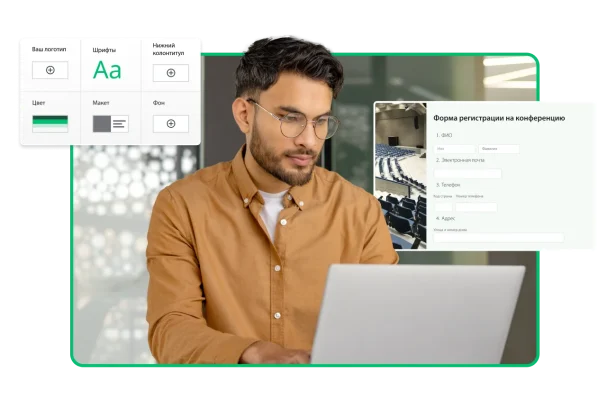Изучите передовые методы составления опросов и форм
Используйте все возможности опросов и форм благодаря ресурсам и статьям от разработчиков SurveyMonkey.






Ознакомьтесь с нашими ресурсами
Рекомендуемые статьи

Точно рассчитайте Net Promoter® Score и получите советы по повышению этого показателя.

Довольны ли ваши сотрудники? Узнайте, как составлять эффективные вопросы, чтобы выяснить это в опросе.

Воспользуйтесь простым способом согласования времени собраний, подходящего для вашей рабочей группы.

Сколько респондентов нужно вам для опроса? Чтобы получить лучшие результаты, воспользуйтесь нашим калькулятором размера выборки.
Передовые методы проведения опросов

Передовые методы проведения опросов и рекомендации по составлению
Составляйте грамотные опросы, собирайте отзывы и анализируйте данные так, как это делают профессионалы.
Узнайте, как создавать опросы, собирать ответы и анализировать данные для принятия оптимальных деловых решений.
Получайте мгновенные отзывы, чтобы оценивать мнения и принимать решения на основе данных в реальном времени.
Узнайте, какие основные типы ошибок встречаются в опросах и как их избегать.
Узнайте об одном из самых надежных методов оценки мнений, восприятий и поведения, а также о том, как использовать этот метод в вашем новом опросе.
Изучите распространенные вопросы для опросов и узнайте, как создавать эффективные опросы, дающие наилучшие результаты.
Отзывы и предложения клиентов

Как создавать успешные программы сбора отзывов и предложений клиентов
Ознакомьтесь с передовыми методами сбора и использования отзывов для улучшения продуктов, услуг и отношений с клиентами.
Узнайте, как использовать индекс потребительских усилий для устранения проблем и повышения лояльности.
Узнайте, как рассчитать NPS и создать опрос для измерения качества обслуживания и уровня удовлетворенности клиентов.
Изучите преимущества и ограничения NPS и узнайте, почему этот показатель так широко используется для оценки лояльности клиентов и прогнозирования роста бизнеса.
Узнайте, как правильно составлять вопросы для опроса об удовлетворенности клиентов, чтобы собирать полезную на практике информацию.
Измерение качества обслуживания по пяти показателям поможет вам найти новые способы радовать клиентов и лучше обслуживать их.
Исследование рынка

Исследование рынка: что это такое, почему оно важно и с чего его следует начинать
Узнайте об ориентированной на данные стратегии, которая позволяет собрать практически полезные сведения о потребителях, настроениях и рынке в целом.
Узнайте, как за считаные минуты создавать эффективные опросы для исследования рынка.
Узнайте, чем вторичное исследование отличается от первичного и почему его следует использовать в вашем бизнесе.
Получайте информацию, необходимую для принятия оптимальных решений по продуктам и услугам.
Ваши результаты статистически значимы? Используйте этот калькулятор, чтобы получить уверенность в результатах опроса.
Отзывы сотрудников

Сбор отзывов сотрудников: советы, примеры и шаблоны
Узнайте, как задавать правильные вопросы, формировать надежную программу сбора отзывов и предложений от сотрудников и использовать результаты для повышения удержания персонала.
Узнайте, какие вопросы надо задавать, чтобы улучшить процесс набора и привлечь самых лучших кандидатов.
Изучите преимущества, которые дают опросы сотрудников для повышения заинтересованности, выявления проблем на рабочем месте и улучшения организационной культуры.
Поддержите своих сотрудников с помощью опросов по обучению, чтобы оценить эффективность программ обучения и выявить области, требующие улучшения.
Изучите стратегии формирования здоровой рабочей культуры посредством понятной коммуникации, признания и инклюзивности.
Получите шаблоны опросов и рекомендации экспертов, чтобы помочь своей организации создать более инклюзивную культуру.
Формы

Создание онлайн-форм
Легко и просто создавайте с помощью SurveyMonkey онлайн-формы и сразу же начинайте собирать ответы.
Получите рекомендации по разработке эффективных онлайн-форм, в том числе полезные советы по структуре, типам вопросов и взаимодействию с пользователями.
Создавайте онлайн-формы для регистрации, которые легко настраивать и заполнять. Выберите из множества шаблонов тот, который соответствует вашим потребностям.
Сбор отзывов непосредственно у клиентов, заказчиков и других лиц поможет вам улучшить свой бизнес, продукт или бренд.
Воспользуйтесь советами по созданию форм для сбора подтверждений ответов на приглашения и узнайте, как собирать и отслеживать ответы гостей для эффективного контроля посещаемости мероприятия.
Повышайте процентную долю ответивших, собирайте контактную информацию и облегчайте регистрацию и подачу заявок с помощью встраиваемых форм.
Исследования и анализ

Как анализировать данные опроса: методы и примеры
Узнайте, как эффективно анализировать данные опросов и с легкостью делать новые опросы лучше.
Обладая правильной информацией и инструментами, вы можете использовать статистические методы для анализа данных опросов, даже не имея квалификации.
Получите подробное представление о зондирующих исследованиях и узнайте о четырех способах их применения в вашей исследовательской работе.
Изучайте причинно-следственные связи и принимайте обоснованные решения, проверяя гипотезы и анализируя результаты.
Ознакомьтесь с нашими советами по использованию количественного анализа, которые помогут исследованиям в вашей компании.
Узнайте, как определить погрешность и сразу же измерить ее с помощью нашего онлайн-калькулятора.
Разработка продукции

Как быстрее создавать более совершенные продукты с помощью моментальной обратной связи
Узнайте, как использовать опросы в процессе разработки продукта для сбора отзывов клиентов, определения потребностей и совершенствования продукта.
Узнайте, как отбор идей помогает обеспечить создание выигрышных продуктов, подкрепленное исследованиями и анализом.
Оценивайте готовность клиентов платить, собирая сведения о стратегиях ценообразования и рыночном спросе.
Собирайте информацию до и после запуска продукта, чтобы повысить его качество и уровень удовлетворенности клиентов.
Протестируйте свою концепцию и идеи продукта на надежной аудитории и получите результаты меньше чем за час.
Узнайте, как спланировать, составить, разослать и проанализировать опрос для проверки концепции, чтобы улучшить следующую рекламную кампанию, запуск продукта и другие мероприятия.
Организация мероприятий

Управление отзывами о мероприятии: опросы до и после
Получите советы и шаблоны, чтобы сделать ваше следующее мероприятие успешным от начала и до конца.
Узнайте, какие вопросы надо задать в опросе, чтобы собрать ценные отзывы на каждом этапе мероприятия.
Получите готовые шаблоны опросов, специально подготовленные для планирования мероприятий, с которыми удобно узнавать о предпочтениях и ожиданиях участников.
Проводите более успешные мероприятия, учитывая отзывы, собранные с помощью опроса участников.
Советы экспертов по сбору полезных сведений для улучшения вашего следующего корпоративного мероприятия или вечеринки.
Будьте подготовлены, сохраняйте организованность и используйте инструменты SurveyMonkey, чтобы ваши мероприятия проходили гладко.
Маркетинг

Маркетинговые опросы, примеры вопросов, шаблоны и т. д.
Создайте маркетинговый опрос за считаные минуты и получите данные, необходимые для повышения уровня удовлетворенности клиентов и качества продуктов, регулирования цен, создания креативных кампаний и т. д.
Разработайте маркетинговую аналитическую картину для принятия более осознанных, стратегических деловых решений.
Узнайте о передовых методах проведения тестирования рекламы, от мозгового штурма вопросов до анализа результатов, и вы сможете найти самый лучший вариант.
Отслеживайте эффективность своего бренда и следите за ее изменением со временем.
Узнайте, как получить убедительные данные для разработки стратегии контент-маркетинга с помощью оригинального исследования.
Узнайте, как профессионалы отрасли используют ИИ в маркетинге, и ознакомьтесь с статистикой исследований SurveyMonkey по использованию ИИ.
Опросы об образовании

Опросы в образовательной сфере для учебных заведений, преподавателей и учащихся
В сотрудничестве с Министерством образования США и Гарвардской высшей педагогической школой мы разработали шаблоны опросов, которые содействуют улучшениям в образовании.
Рассылайте образовательные опросы учащимся, учителям и родителям, чтобы узнать, как обстоят дела в вашей школе или университете — помимо всего прочего.
Поймите, что нужно учащимся, что они предпочитают и какие у них проблемы, чтобы создать более благоприятную образовательную среду.
Улучшите процесс преподавания, используя опросы для учащихся. Получайте честные отзывы об уроках, занятиях и о многом другом, чтобы сделать учебу лучше.
Используйте шаблон опроса в системе К-12, разработанный SurveyMonkey и Гарвардской высшей педагогической школой, чтобы повысить вовлеченность родителей.
Добавьте глубины своим научным исследованиям, используя полученные в опросах данные и аналитику.
Опросы в сфере здравоохранения

Опрос в сфере здравоохранения: вопросы и шаблоны
Используйте опросы в сфере здравоохранения для сбора отзывов пациентов, повышения качества обслуживания и поддержки принятия решений в медицинских учреждениях.
Используйте опросы об уровне удовлетворенности пациентов для оценки качества медицинского обслуживания и содействия его улучшению.
Используйте этот шаблон опроса для оценки и повышения культуры безопасности пациентов в вашей медицинской организации.
Узнайте, как использовать опросы для сбора важных данных, необходимых для клинических исследований, оценки состояния пациентов и развития здравоохранения.
Узнайте, как SurveyMonkey помогает клиентам, которым необходимо соблюдать требования HIPAA.
Воспользуйтесь образцами вопросов для оценочных опросов и примерами опросов в сфере здравоохранения, а также узнайте, как профессионально составлять вопросы для медицинских опросов.
Тесты

Создавайте эффективные тесты, используя эти советы по составлению вопросов, форматированию и использованию тестов для вовлечения и оценки.
Опросы для некоммерческих организаций

Получите ценные отзывы от спонсоров, волонтеров и организаторов благотворительных акций с помощью онлайн-опросов.
Net Promoter, Net Promoter® Score и NPS являются торговыми знаками Satmetrix Systems, Inc., Bain & Company, Inc. и Fred Reichheld.